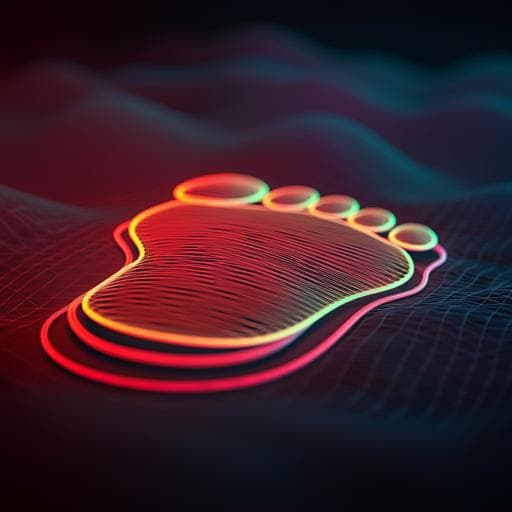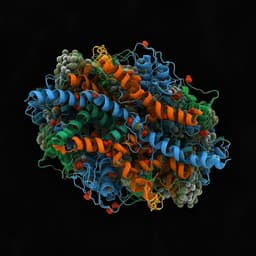
Engineering and Technology
Rational design of a laminate-structured flexible sensor for human dynamic plantar pressure monitoring
Z. Xiong, Y. Bai, et al.
This groundbreaking research by Zuoping Xiong, Yuanyuan Bai, Lianhui Li, Zhen Zhou, Tie Li, and Ting Zhang introduces a theoretical model for a flexible pressure sensor with an innovative structure. The study demonstrates remarkable stability and durability, making it ideal for real-time wearable monitoring of plantar pressure during exercise and rehabilitation activities.
~3 min • Beginner • English
Introduction
The study addresses the need for high-performance flexible pressure sensors that can conform to curved, dynamic surfaces in applications such as epidermal electronics, biomedicine, and human–computer interaction. Conventional MEMS-based semiconductor pressure sensors, while accurate and reliable, are rigid and not well suited to flexible surfaces. Although micro/nanostructured flexible sensors can enhance sensitivity, they face challenges in stability under cyclic loading and scalability for mass production. The research question focuses on establishing an efficient, predictive model for flexible piezoresistive pressure sensors with a simple laminate structure, enabling rational design to meet target performance (sensitivity, detection limit, durability) without complex microstructuring. The purpose is to introduce and validate a finite element model that incorporates the electrical constriction effect to explain and tune sensor performance across a broad pressure range, and to demonstrate practical utility with a wearable plantar pressure monitoring system.
Literature Review
Prior studies have pursued sensitivity enhancement in flexible capacitive/pressure sensors through engineered microstructures. Examples include pyramidal microstructures optimized for compressibility (Bao et al.) and systematic analyses of sensitivity and linearity across different microstructures (Yang et al.). Other reported strategies include porous, biomimetic, and serpentine structures. However, such microstructured substrates can suffer from limited stability during cyclic use and challenges in large-scale production. Finite element modeling is well established for MEMS sensors to enable rational design, but efficient, accurate models tailored to flexible piezoresistive pressure sensors remain lacking. This gap motivates the present work to provide a predictive model incorporating interfacial electrical constriction effects for laminate-structured flexible sensors.
Methodology
Design: A laminate-structured flexible pressure sensor was designed with a flexible sensing layer facing a flexible interdigital electrode layer, separated by a ring spacer that creates an air gap. Under applied normal pressure on the sensing layer, the top substrate bends toward the electrode layer until contact occurs, forming conductive paths at the interface.
Finite element modeling: Using COMSOL Multiphysics, coupled solid mechanics and electric currents physics were set up. Mechanical deformation was modeled via Lagrangian equilibrium equations with the deformation gradient tensor and second Piola–Kirchhoff stress tensor. Steady-state mechanical response under applied pressure was solved to obtain displacement, stress, and strain fields. Volumetric strain distributions in the sensitive layer were computed to understand compression/tension regions and average strain evolution with pressure.
Interfacial contact and electrical constriction: Upon mechanical contact, an electrical contact is assumed at the sensing layer–electrode interface. To capture the electrical constriction effect due to microscale roughness and contact spots, the interfacial conductivity was defined as sigma_x = C + k * T^-n, where C is the smooth-interface conductivity, k relates to surface roughness and effective material moduli/Poisson’s ratio, T is local contact pressure, and n is between 0 and 1. Thus, local contact pressure distributions obtained from mechanics directly inform interfacial conductance.
Electrical simulation: A 2 V potential difference was applied across the interdigital electrodes. Current density distributions in electrodes (parallel component) and through the sensitive layer (perpendicular component) were computed as functions of applied pressure, using Ohm’s law and the pressure-dependent interfacial conductivity. Total current vs pressure curves were generated.
Parametric studies: The model evaluated (i) detection limit dependence on substrate Young’s modulus, (ii) effects of substrate thickness and air-gap thickness on detection limit, and (iii) influence of interdigital electrode geometry (width and gap) on contact pressure coverage and current. Results considering the constriction effect were compared against simulations neglecting it.
Experimental validation and application: A laminate-structured flexible pressure sensor was fabricated and tested to confirm model predictions. Long-term cycling stability and durability (including in salt solution) were evaluated. A wearable sensing system comprising sensor arrays was integrated for real-time plantar pressure data collection and analysis to demonstrate dynamic human plantar pressure monitoring.
Key Findings
- Introduction of electrical constriction effect into the finite element model successfully explains and predicts the sensitivity tuning of a laminate-structured flexible pressure sensor across a broad pressure range.
- Mechanical response: As pressure increases, the top substrate bends until contact; maximum displacement and stress increase then saturate. High stress localizes at the ring spacer–substrate boundary and at the contact edge with electrodes, indicating potential failure sites.
- Contact mechanics: Contact pressure initiates centrally and spreads outward with increasing load; average contact pressure increases linearly with applied pressure, while contact area grows rapidly at low pressure and becomes nearly constant at high pressure.
- Electromechanical coupling: Total current increases sharply in the low-pressure regime (dominated by rapid growth of contact area) and nearly linearly in the high-pressure regime (dominated by increasing contact pressure). Inclusion of constriction effect yields current–pressure behavior matching these regimes; simulations without constriction fail to capture the same trend.
- Current density evolution: Beyond a critical pressure (detection limit), maximum current density increases by roughly three orders of magnitude; current flows from one electrode through the sensitive film across the interface to the other electrode.
- Detection limit tuning: The detection limit decreases linearly with decreasing Young’s modulus of the flexible substrate. It decreases exponentially with decreasing thickness of either the air gap or the substrate. Thinner air gaps/substrates and softer substrates lower the detection limit.
- Electrode geometry: Interdigital electrode geometry does not affect detection limit. Increasing electrode width reduces average contact pressure but increases coverage area, raising current. Increasing electrode gap increases average contact pressure but reduces coverage area, lowering current.
- Experimental performance: The fabricated sensor validates the model and exhibits excellent stability up to 3,000,000 cycles and superior durability in salt solution, attributed to the simple laminated and enclosed structure.
- Application: A wearable system using sensor arrays enables real-time dynamic plantar pressure acquisition and analysis for exercise and rehabilitation monitoring.
Discussion
The research demonstrates that incorporating the electrical constriction effect into a finite element framework provides a physically grounded explanation for how a simple laminate architecture achieves high performance without complex microstructuring. The model links mechanical contact evolution (area and pressure distribution) to interfacial conductance, accounting for sharp sensitivity at low pressures (rapid contact area growth) and near-linear response at higher pressures (linear increase of average contact pressure). It identifies design levers to achieve target detection limits: softer substrates and reduced substrate/air-gap thickness. The analysis of stress localization highlights probable failure regions (spacer–substrate boundary and electrode contact edge), informing reliability-oriented structural reinforcement. Electrode geometry is shown to modulate current magnitude via contact coverage and pressure while not altering detection limit, guiding layout optimization for signal strength. Experimental validation, long-cycle stability, salt-solution durability, and successful integration into a wearable plantar pressure system collectively support the model’s relevance for practical, robust flexible sensing in human motion and rehabilitation contexts.
Conclusion
This work establishes and validates a finite element model for laminate-structured flexible pressure sensors that integrates the electrical constriction effect to accurately predict and tune performance across a wide pressure range. The model clarifies the roles of contact area and pressure, reveals stress concentration zones relevant to durability, and provides quantitative guidance for lowering detection limits via substrate stiffness and thickness/air-gap reduction. A fabricated sensor corroborates model predictions and demonstrates outstanding stability (up to 3 million cycles) and durability in saline environments. The approach enables rapid, rational design of flexible pressure sensors for real-world applications, exemplified by a wearable system achieving real-time dynamic plantar pressure monitoring for exercise and rehabilitation.
Limitations
- The finite element model relies on parameters (e.g., k and n in the constriction conductivity relation, effective moduli, interfacial roughness) that may vary with materials and surface conditions; accurate parameterization is required for quantitative prediction across different material systems.
- Stress concentrations at the spacer–substrate boundary and electrode contact edge suggest potential debonding/failure under extreme or prolonged loading, indicating a need for structural reinforcement or material optimization in these regions.
- Detailed fabrication parameters and comprehensive material property characterizations (e.g., long-term effects of environmental exposure beyond salt solution) are referenced to supplementary materials and are not fully detailed in the main text, which may limit immediate replicability and generalization to other platforms.
Related Publications
Explore these studies to deepen your understanding of the subject.







